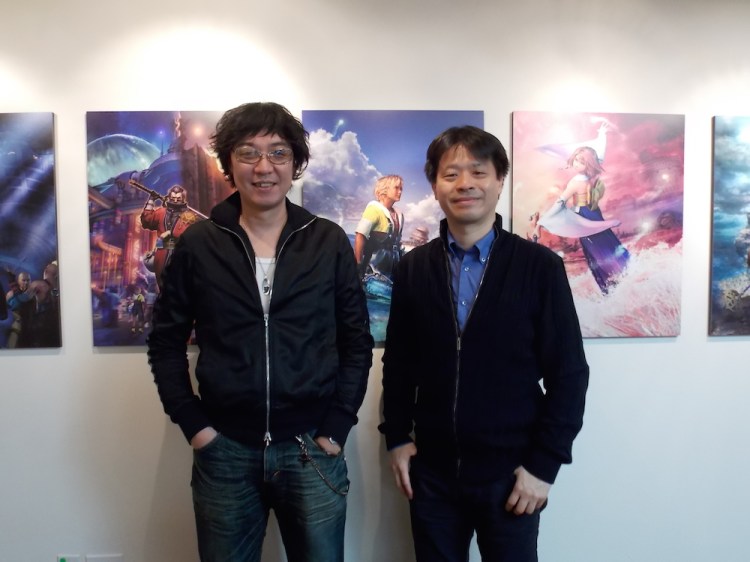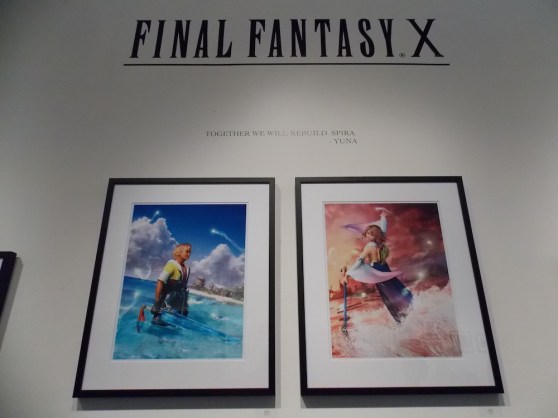ALHAMBRA, Calif. — Printed on one of the large white walls at Gallery Nucleus are five simple words: “Together we will rebuild Spira.” In the Japanese role-playing game Final Fantasy X, the heroes have to stop a monstrous creature known as Sin from destroying their world. While they eventually succeed, natural disasters in real life rarely have a happy ending.
In November, Typhoon Haiyan struck the Philippines, killing over 6,000 people and displacing millions more. To help rebuild parts of the country, developer Square Enix teamed up with the gallery to auction off original art pieces from Final Fantasy X and its sequel, Final Fantasy X-2. Both PlayStation 2 games were recently updated for modern consoles as part of an HD Remaster package (read our review here). The online auction ends on March 26, and all proceeds will go directly to Haiyan relief efforts.
Despite the sad occasion that prompted the charity event, the first day of the auction was also a day of celebration. In addition to viewing the art pieces in person, attendees could buy the game a few days ahead of its release as well as a plethora of FFX and X-2-related merchandise.
But the main draw, however, and the reason why hundreds of people lined up outside despite the sweltering 80-degree weather, was for the chance to meet veteran Final Fantasy producer Yoshinori Kitase and art director Yusuke Naora.
GamesBeat spoke with both the developers and the fans to find out what makes FFX and FFX-2 so special more than 10 years after their release.
Rekindling their love
Kitase and Naora have each worked on multiple games in the Final Fantasy series, but they both have a soft spot for the world and characters from FFX and FFX-2.
“Final Fantasy X was very special to me, just like Final Fantasy VII [which he also worked on],” said Yusuke Naora through a translator. “But unlike Final Fantasy VII, which has various spinoffs like [the film] Advent Children, I thought that Final Fantasy X was a game that I’d never be able to touch or do anything with [again].”
For Kitase, FFX fulfilled a vision he had for the series ever since he worked on his first Final Fantasy game, Final Fantasy V for the Super Nintendo. At the time, he felt that the games were “flat” compared to movies. They relied solely on text boxes for dialogue, and the limitations of the hardware meant that the team had to use 2D worlds and character sprites to tell their stories. The lack of realistic graphics and voice acting “were the kinds of gaps I was seeing between films and the FF games,” he said.
While the graphics dramatically improved when the franchise moved to Sony’s more powerful PlayStation console, they still weren’t enough to satisfy Kitase’s ambition. It wasn’t until FFX that Square was able to use “more movie-like camera work” and finally hire actors to bring the game’s ensemble cast to life.
“FFX is the game where I felt I was able to fulfill those last missing pieces and accomplish something I was envisioning back when I was working on FFV,” he said. “It has a very special significance for me.”
One particular moment from FFX’s PS2 development stands out in Kitase’s mind.
“When we were initially working on FFX, we were working with low-resolution graphics,” he said. “So the textures were kind of rough. The next-gen consoles at the time, such as the [Sega] Dreamcast, were coming out, so it was a very difficult thing for the team to [continue working with the low-res textures]. Two to three months before gold master was ready [the point at which a game can be mass-produced], I said to the team, ‘You know what? All these competitive consoles are coming out. Let’s really bring up the quality of the graphics.’ … We actually had a lot of arguments and fights over this because it was very difficult for us to go back and re-do them. [Laughs]”
In hindsight, Kitase said those fights were worth it because the extra work they put into the game made it easier for them to work on the HD rerelease.



